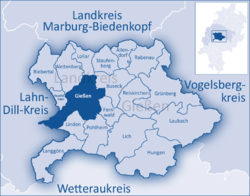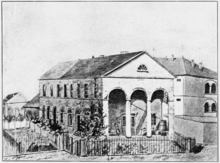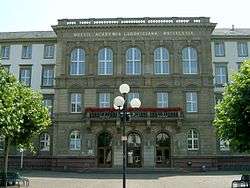Giessen
| Giessen | ||
|---|---|---|
|
| ||
| ||
 Giessen | ||
Location of Giessen within Giessen district  | ||
| Coordinates: 50°35′0″N 8°40′0″E / 50.58333°N 8.66667°ECoordinates: 50°35′0″N 8°40′0″E / 50.58333°N 8.66667°E | ||
| Country | Germany | |
| State | Hesse | |
| Admin. region | Giessen | |
| District | Giessen | |
| Government | ||
| • Lord Mayor | Dietlind Grabe-Bolz (SPD) | |
| Area | ||
| • Total | 72.56 km2 (28.02 sq mi) | |
| Population (2015-12-31)[1] | ||
| • Total | 84,455 | |
| • Density | 1,200/km2 (3,000/sq mi) | |
| Time zone | CET/CEST (UTC+1/+2) | |
| Postal codes | 35390–35398 | |
| Dialling codes | 0641, 06403 | |
| Vehicle registration | GI | |
| Website | www.giessen.de | |
Giessen, spelled Gießen in German (German pronunciation: [ˈɡiːsən]), is a town in the German federal state (Bundesland) of Hesse, capital of both the district of Giessen and the administrative region of Giessen. The population is approximately 78,000, with roughly 24,000 university students.
The name comes from Giezzen, as it was first referred to in 1197, which refers to the position of the town between several rivers, lakes and streams. The largest river in Giessen is the Lahn, which divides the town in two parts (west and east), roughly 50 kilometres (31 miles) north of Frankfurt am Main.
In 1969, the town hosted the ninth Hessentag state festival.
History
Giessen came into being as a moated castle in 1152 built by Count Wilhelm von Gleiberg,[2] although the history of the community in the northeast and in today's suburb called "Wieseck" dates back to 775. The town became part of Hesse-Marburg in 1567, passing to Hesse-Darmstadt in 1604. The University of Giessen was founded in 1607. Giessen was included within the Grand Duchy of Hesse created in 1806 during the Napoleonic Wars. After World War I, it was part of the People's State of Hesse.
During World War II, a subcamp of the Buchenwald concentration camp was located in the Heil- und Pflegeanstalt Licher Straße.[3][4][5] Heavy bombing destroyed about 75% of Gießen in 1944, including most of the town's historic buildings. It became part of the modern state of Hesse after the war.
In 1977, Giessen was merged with the neighbouring city Wetzlar to form the new city of Lahn. However, this attempt to reorganize the administration was reversed in 1979. It was bounded to Darmstadt (region) between 1945 and 1981 until Giessen (region) was founded on 1 January 1981.
An American military base was located in Giessen after World War II. The U.S. Army Garrison of Gießen had a population of 500 Americans. The base is a converted German Army Air Field which is reflected in some of the buildings including the housing area. A theatre, known as the Keller Theatre, is a converted German army Officer's Club. As of September 28, 2007, the Giessen Depot and all other communities in the greater Giessen area were turned back over to the local German authorities.
After the war, the city was twinned with Winchester, UK.[6]
| Largest groups of foreign residents | |
| Nationality | Population (2011) |
|---|---|
| 1,922 | |
| 569 | |
| 425 | |
International relations
Twin towns — sister cities
|
|
Points of interest
- Akademischer Forstgarten Gießen, botanical gardens
- Botanischer Garten Gießen, established in 1609, the oldest botanical garden in Germany still at its original location.
- Old Cemetery, (German: Alter Friedhof), resting place of Wilhelm Conrad Röntgen and Hugo von Ritgen.
- Liebig-Museum, established in 1920, to honor the chemist Justus von Liebig.
- Mathematikum, established in 2002, offering a huge variety of mathematical hands-on exhibits.
- University of Giessen
- Rubber Island, a residential area near the Lahn River.
Sport
Giessen is home to the basketball club Giessen 46ers, five time champion of the Basketball Bundesliga. Its home games take place at the Sporthalle Gießen-Ost.
Gallery
.jpg) Historical drawing of the marketplace, 1844
Historical drawing of the marketplace, 1844 Historical drawing of the Akademischer Forstgarten Gießen, 1877
Historical drawing of the Akademischer Forstgarten Gießen, 1877

 Architecture in Gießen
Architecture in Gießen- Röntgen memorial
 Liebig laboratory, 1909
Liebig laboratory, 1909 Multiway pedestrian bridge "Elephant loo"
Multiway pedestrian bridge "Elephant loo"
Notable people
- Samuel Adler (1809–1891), a noted rabbi in the United States, attended the University of Giessen[10]
- Annika Beck (b. 1994), professional tennis player
- Stefan Bellof (1957–1985), Formula One and Sportscar driver, who was killed during a race held in Spa-Francorchamps
- Christa Blanke (b. 1948), theologist, founder of Animals' Angels e.V.
- Georg Büchner (1813–1837) studied two years at the University of Gießen
- Daniel Davari (b. 1988), Iranian footballer.
- Walter Dornberger (1895–1980), rocket scientist
- Peter Düttmann (1923-2001), Luftwaffe Ace
- Landgravine Elisabeth Amalie of Hesse-Darmstadt (1635–1709), Electress Palatine, ancestress of most of today's royals
- Charles Friedek (b. 1971), triple jumper
- Adolph Hansen (1851–1920), botanist and professor at University of Giessen
- Fritz Heichelheim (1901–1968), economist
- Juli, rock band
- Friedrich Kellner (1885–1970), Chief Regional Auditor in Giessen 1948-1950, and Chief Justice Inspector of Laubach, where he wrote his secret WWII diary. The Holocaust Research Unit of Justus Liebig University of Giessen has established the Kellner Project
- Karl Kling (1910-2003), Racing driver and head of Mercedes-Benz Motorsport
- Jonathan Koch (b. 1985), rower
- Chris Liebing (b. 1968) techno/electronic music producer and DJ
- Justus von Liebig (1803–1873), chemist, professor. The official name of the University of Giessen is now Justus Liebig University
- Wilhelm Liebknecht (1826–1900), founder of the Social Democratic Party of Germany, was born on March 29, 1826 in Giessen
- Sigmund Livingston (1872–1946), American lawyer, founder and first president of the Anti-Defamation League
- Christopher Ludwick (1720–1801) Baker General for the American Revolutionary War Army - Philadelphia
- Wangari Maathai, Nobel Laureate 2004
- Alfred Milner (1854–1925), British statesman
- Demis Nikolaidis (b. 1973), Greek footballer
- James J. O'Donnell (b. 1950), American scholar and University administrator, born in Giessen
- Wilhelm Conrad Röntgen (1845–1923), physicist, professor of physics from 1879 until 1888 at the University of Giessen. He was buried at the "Alte Friedhof", where his tomb can still be found
- Johann Georg Rosenmüller (1736–1815), professor of theology at the university
- Til Schweiger (b. 1968), actor, director and producer. Grew up, went to school and started studying in Giessen
- Wilhelm Sievers (1860–1921), geographer, explorer, professor at the university
- Marie Wittich (1868–1931), opera singer
- Willy Zschietzschmann (b. 1900), Classical archeologist and author
Education
- MBML: The International Graduate Programme "Molecular Biology and Medicine of the Lung" of the University of Giessen Lung Center
- University hospital Giessen und Marburg
- Mittelhessen University of Applied Sciences
- University of Giessen
Manisch
Manisch is a dialect of rotwelsch spoken in and around Giessen by people in lower income neighbourhoods, some of which are known as "Eulenkopf", "Gummiinsel", "Heyerweg" and "Margaretenhütte". Approximately 700–750 residents spoke the dialect fluently as of 1976.[11] Although the dialect still influences the Giessen vernacular, it is nearly extinct in terms of fluent speakers.
Geography
Climate
Climate in this area has mild differences between highs and lows, and there is adequate rainfall year-round. The Köppen Climate Classification subtype for this climate is "Cfb". (Marine West Coast Climate).
| Climate data for Giessen | |||||||||||||
|---|---|---|---|---|---|---|---|---|---|---|---|---|---|
| Month | Jan | Feb | Mar | Apr | May | Jun | Jul | Aug | Sep | Oct | Nov | Dec | Year |
| Average high °C (°F) | 3 (37) |
4 (40) |
8 (47) |
13 (56) |
18 (65) |
21 (70) |
23 (73) |
22 (71) |
18 (65) |
12 (54) |
7 (44) |
3 (38) |
13 (55) |
| Average low °C (°F) | −2 (28) |
−2 (29) |
1 (33) |
3 (38) |
8 (46) |
11 (51) |
13 (55) |
12 (53) |
9 (48) |
5 (41) |
2 (35) |
−1 (30) |
5 (41) |
| Average precipitation mm (inches) | 46 (1.8) |
36 (1.4) |
36 (1.4) |
41 (1.6) |
50 (2) |
61 (2.4) |
74 (2.9) |
61 (2.4) |
48 (1.9) |
56 (2.2) |
46 (1.8) |
50 (2) |
602 (23.7) |
| Source: Weatherbase [12] | |||||||||||||
See also
- Giessen station
- Giessen 46ers — Basketball club
- Giessen emigration society — founded 1833
References
- Notes
- ↑ "Bevölkerung der hessischen Gemeinden". Hessisches Statistisches Landesamt (in German). August 2016.
- ↑
 Chisholm, Hugh, ed. (1911). "Giessen". Encyclopædia Britannica. 12 (11th ed.). Cambridge University Press. p. 4.
Chisholm, Hugh, ed. (1911). "Giessen". Encyclopædia Britannica. 12 (11th ed.). Cambridge University Press. p. 4. - ↑ Edward Victor. Alphabetical List of Camps, Subcamps and Other Camps.
- ↑ 1933-1945 Lager G. Tenhumberg Reinhard. Retrieved 2014-08-03.
- ↑ Hessian Regional History Information System (LAGIS)
- ↑ "USAG Giessen Folds Up Tent". Retrieved 2008-05-08.
- ↑ "Gießen: Städtepartnerschaften" [Giessen: Twin towns] (in German). Stadt Gießen. Archived from the original on 2013-04-13. Retrieved 2013-08-01.
- ↑ "Netanya - Twin Cities". Netanya Municipality. Archived from the original on 2013-02-01. Retrieved 2013-08-01.
- ↑ "Twin Towns in Hampshire". Www3.hants.gov.uk. Retrieved 2009-11-06.
- ↑ Who Was Who in America, Historical Volume, 1607-1896. Marquis Who's Who. 1967.
- ↑ Hans-Günter Lerch, "Tschü lowi...Das Manische in Gießen", 1976/2005, pages 16-22.
- ↑ "Weatherbase.com". Weatherbase. 2013. Retrieved on May 9, 2013.
External links
| Wikimedia Commons has media related to Giessen. |
-
 Giessen travel guide from Wikivoyage
Giessen travel guide from Wikivoyage - City Services Giessen (SWG)
- Express Magazine - Current events and news from Giessen

